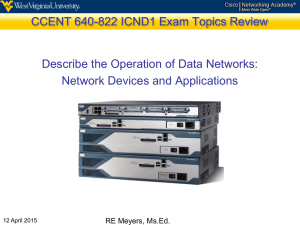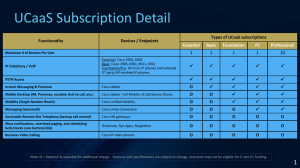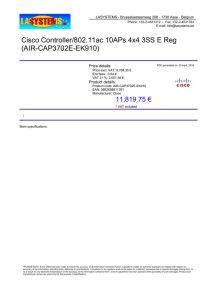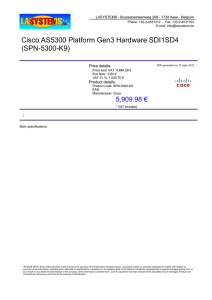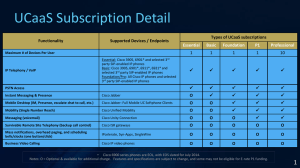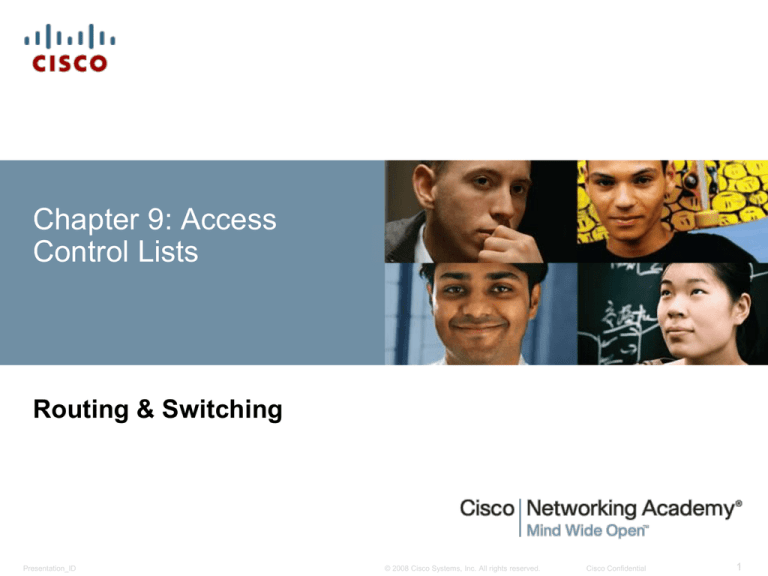
Chapter 9: Access
Control Lists
Routing & Switching
Presentation_ID
© 2008 Cisco Systems, Inc. All rights reserved.
Cisco Confidential
1
Chapter 9
9.1 IP ACL Operation
9.2 Standard IPv4 ACLs
9.3 Extended IPv4 ACLSs
9.4 Contextual Unit: Debug with ACLs
9.5 Troubleshoot ACLs
9.6 Contextual Unit: IPv6 ACLs
9.7 Summary
Presentation_ID
© 2008 Cisco Systems, Inc. All rights reserved.
Cisco Confidential
2
Purpose of ACLs
What is an ACL?
Presentation_ID
© 2008 Cisco Systems, Inc. All rights reserved.
Cisco Confidential
3
Purpose of ACLs
A TCP Conversation
Presentation_ID
© 2008 Cisco Systems, Inc. All rights reserved.
Cisco Confidential
4
Purpose of ACLs
Packet Filtering
Packet filtering, sometimes called static packet filtering,
controls access to a network by analyzing the incoming
and outgoing packets and passing or dropping them
based on given criteria, such as the source IP address,
destination IP addresses, and the protocol carried
within the packet.
A router acts as a packet filter when it forwards or
denies packets according to filtering rules.
An ACL is a sequential list of permit or deny
statements, known as access control entries (ACEs).
Presentation_ID
© 2008 Cisco Systems, Inc. All rights reserved.
Cisco Confidential
5
Purpose of ACLs
Packet Filtering (Cont.)
Presentation_ID
© 2008 Cisco Systems, Inc. All rights reserved.
Cisco Confidential
6
Purpose of ACLs
ACL Operation
The last statement of an ACL is always an implicit deny.
This statement is automatically inserted at the end of
each ACL even though it is not physically present. The
implicit deny blocks all traffic. Because of this implicit
deny, an ACL that does not have at least one permit
statement will block all traffic.
Presentation_ID
© 2008 Cisco Systems, Inc. All rights reserved.
Cisco Confidential
7
Standard versus Extended IPv4 ACLs
Types of Cisco IPv4 ACLs
Standard ACLs
Extended ACLs
Presentation_ID
© 2008 Cisco Systems, Inc. All rights reserved.
Cisco Confidential
8
Standard versus Extended IPv4 ACLs
Numbering and Naming ACLs
Presentation_ID
© 2008 Cisco Systems, Inc. All rights reserved.
Cisco Confidential
9
Wildcard Masks in ACLs
Introducing ACL Wildcard Masking
Wildcard masks and subnet masks differ in the way they
match binary 1s and 0s. Wildcard masks use the
following rules to match binary 1s and 0s:
Wildcard mask bit 0 - Match the corresponding bit value
in the address.
Wildcard mask bit 1 - Ignore the corresponding bit
value in the address.
Wildcard masks are often referred to as an inverse mask.
The reason is that, unlike a subnet mask in which binary
1 is equal to a match and binary 0 is not a match, in a
wildcard mask the reverse is true.
Presentation_ID
© 2008 Cisco Systems, Inc. All rights reserved.
Cisco Confidential
10
Wildcard Masks in ACLs
Wildcard Mask Examples: Hosts / Subnets
Presentation_ID
© 2008 Cisco Systems, Inc. All rights reserved.
Cisco Confidential
11
Wildcard Masks in ACLs
Wildcard Mask Examples: Match Ranges
Presentation_ID
© 2008 Cisco Systems, Inc. All rights reserved.
Cisco Confidential
12
Wildcard Masks in ACLs
Calculating the Wildcard Mask
Calculating wildcard masks can be challenging. One
shortcut method is to subtract the subnet mask from
255.255.255.255.
Presentation_ID
© 2008 Cisco Systems, Inc. All rights reserved.
Cisco Confidential
13
Wildcard Masks in ACLs
Wildcard Mask Keywords
Presentation_ID
© 2008 Cisco Systems, Inc. All rights reserved.
Cisco Confidential
14
Wildcard Masks in ACLs
Examples Wildcard Mask Keywords
Presentation_ID
© 2008 Cisco Systems, Inc. All rights reserved.
Cisco Confidential
15
Guidelines for ACL creation
General Guidelines for Creating ACLs
Use ACLs in firewall routers positioned between your
internal network and an external network such as the
Internet.
Use ACLs on a router positioned between two parts of
your network to control traffic entering or exiting a
specific part of your internal network.
Configure ACLs on border routers, that is routers
situated at the edges of your networks.
Configure ACLs for each network protocol configured
on the border router interfaces.
Presentation_ID
© 2008 Cisco Systems, Inc. All rights reserved.
Cisco Confidential
16
Guidelines for ACL creation
General Guidelines for Creating ACLs
The Three Ps
One ACL per protocol - To control traffic flow on an
interface, an ACL must be defined for each protocol
enabled on the interface.
One ACL per direction - ACLs control traffic in one
direction at a time on an interface. Two separate ACLs
must be created to control inbound and outbound
traffic.
One ACL per interface - ACLs control traffic for an
interface, for example, GigabitEthernet 0/0.
Presentation_ID
© 2008 Cisco Systems, Inc. All rights reserved.
Cisco Confidential
17
Guidelines for ACL creation
ACL Best Practices
Presentation_ID
© 2008 Cisco Systems, Inc. All rights reserved.
Cisco Confidential
18
Guidelines for ACL Placement
Where to Place ACLs
Every ACL should be placed where it has the greatest
impact on efficiency. The basic rules are:
Extended ACLs: Locate extended ACLs as close as
possible to the source of the traffic to be filtered.
Standard ACLs: Because standard ACLs do not specify
destination addresses, place them as close to the
destination as possible.
Placement of the ACL and therefore the type of ACL
used may also depend on: the extent of the network
administrator’s control, bandwidth of the networks
involved, and ease of configuration.
Presentation_ID
© 2008 Cisco Systems, Inc. All rights reserved.
Cisco Confidential
19
Guidelines for ACL Placement
Standard ACL Placement
Presentation_ID
© 2008 Cisco Systems, Inc. All rights reserved.
Cisco Confidential
20
Guidelines for ACL Placement
Extended ACL Placement
Presentation_ID
© 2008 Cisco Systems, Inc. All rights reserved.
Cisco Confidential
21
Configure Standard IPv4 ACLs
Entering Criteria Statements
Presentation_ID
© 2008 Cisco Systems, Inc. All rights reserved.
Cisco Confidential
22
Configure Standard IPv4 ACLs
Configuring a Standard ACL
Example ACL
access-list 2 deny host 192.168.10.10
access-list 2 permit 192.168.10.0 0.0.0.255
access-list 2 deny 192.168.0.0 0.0.255.255
access-list 2 permit 192.0.0.0 0.255.255.255
Presentation_ID
© 2008 Cisco Systems, Inc. All rights reserved.
Cisco Confidential
23
Configure Standard IPv4 ACLs
Configuring a Standard ACL (Cont.)
The full syntax of the standard ACL command is as
follows:
Router(config)# access-list access-list-number
deny permit remark source [ source-wildcard ] [
log ]
To remove the ACL, the global configuration no
access-list command is used.
The remark keyword is used for documentation and
makes access lists a great deal easier to understand.
Presentation_ID
© 2008 Cisco Systems, Inc. All rights reserved.
Cisco Confidential
24
Configure Standard IPv4 ACLs
Internal Logic
Cisco IOS applies an internal logic when accepting and
processing standard access list statements. As
discussed previously, access list statements are
processed sequentially. Therefore, the order in which
statements are entered is important.
Presentation_ID
© 2008 Cisco Systems, Inc. All rights reserved.
Cisco Confidential
25
Configure Standard IPv4 ACLs
Applying Standard ACLs to Interfaces
After a standard ACL is configured, it is linked to an
interface using the ip access-group command in
interface configuration mode:
Router(config-if)# ip access-group {
access-list-number | access-list-name } {
in | out }
To remove an ACL from an interface, first enter the no
ip access-group command on the interface, and then
enter the global no access-list command to remove
the entire ACL.
Presentation_ID
© 2008 Cisco Systems, Inc. All rights reserved.
Cisco Confidential
26
Configure Standard IPv4 ACLs
Applying Standard ACLs to Interfaces (Cont.)
Presentation_ID
© 2008 Cisco Systems, Inc. All rights reserved.
Cisco Confidential
27
Configure Standard IPv4 ACLs
Creating Named Standard ACLs
Presentation_ID
© 2008 Cisco Systems, Inc. All rights reserved.
Cisco Confidential
28
Configure Standard IPv4 ACLs
Commenting ACLs
Presentation_ID
© 2008 Cisco Systems, Inc. All rights reserved.
Cisco Confidential
29
Modify IPv4 ACLs
Editing Standard Numbered ACLs
Presentation_ID
© 2008 Cisco Systems, Inc. All rights reserved.
Cisco Confidential
30
Modify IPv4 ACLs
Editing Standard Numbered ACLs (Cont.)
Presentation_ID
© 2008 Cisco Systems, Inc. All rights reserved.
Cisco Confidential
31
Modify IPv4 ACLs
Editing Standard Named ACLs
Presentation_ID
© 2008 Cisco Systems, Inc. All rights reserved.
Cisco Confidential
32
Modify IPv4 ACLs
Verifying ACLs
Presentation_ID
© 2008 Cisco Systems, Inc. All rights reserved.
Cisco Confidential
33
Modify IPv4 ACLs
ACL Statistics
Presentation_ID
© 2008 Cisco Systems, Inc. All rights reserved.
Cisco Confidential
34
Modify IPv4 ACLs
Standard ACL Sequence Numbers
Another part of the IOS internal logic involves the
internal sequencing of standard ACL statements.
Range statements that deny three networks are
configured first followed by five host statements. The
host statements are all valid statements because their
host IP addresses are not part of the previously entered
range statements.
The host statements are listed first by the show
command, but not necessarily in the order that they
were entered. The IOS puts host statements in an order
using a special hashing function. The resulting order
optimizes the search for a host ACL entry.
Presentation_ID
© 2008 Cisco Systems, Inc. All rights reserved.
Cisco Confidential
35
Securing VTY ports with a Standard IPv4 ACL
Configuring a Standard ACL to Secure a VTY Port
Filtering Telnet or SSH traffic is typically considered an
extended IP ACL function because it filters a higher level
protocol. However, because the access-class
command is used to filter incoming or outgoing
Telnet/SSH sessions by source address, a standard ACL
can be used.
Router(config-line)# access-class accesslist-number { in [ vrf-also ] | out }
Presentation_ID
© 2008 Cisco Systems, Inc. All rights reserved.
Cisco Confidential
36
Securing VTY ports with a Standard IPv4 ACL
Verifying a Standard ACL used to Secure a VTY Port
Presentation_ID
© 2008 Cisco Systems, Inc. All rights reserved.
Cisco Confidential
37
Structure of an Extended IPv4 ACL
Extended ACLs
Presentation_ID
© 2008 Cisco Systems, Inc. All rights reserved.
Cisco Confidential
38
Structure of an Extended IPv4 ACL
Extended ACLs (Cont.)
Presentation_ID
© 2008 Cisco Systems, Inc. All rights reserved.
Cisco Confidential
39
Configure Extended IPv4 ACLs
Configuring Extended ACLs
The procedural steps for configuring extended ACLs are
the same as for standard ACLs. The extended ACL is
first configured, and then it is activated on an interface.
However, the command syntax and parameters are more
complex to support the additional features provided by
extended ACLs.
Presentation_ID
© 2008 Cisco Systems, Inc. All rights reserved.
Cisco Confidential
40
Configure Extended IPv4 ACLs
Applying Extended ACLs to Interfaces
Presentation_ID
© 2008 Cisco Systems, Inc. All rights reserved.
Cisco Confidential
41
Configure Extended IPv4 ACLs
Filtering Traffic with Extended ACLs
Presentation_ID
© 2008 Cisco Systems, Inc. All rights reserved.
Cisco Confidential
42
Configure Extended IPv4 ACLs
Creating Named Extended ACLs
Presentation_ID
© 2008 Cisco Systems, Inc. All rights reserved.
Cisco Confidential
43
Configure Extended IPv4 ACLs
Verifying Extended ACLs
Presentation_ID
© 2008 Cisco Systems, Inc. All rights reserved.
Cisco Confidential
44
Configure Extended IPv4 ACLs
Editing Extended ACLs
Editing an extended ACL can be accomplished using the
same process as editing a standard. An extended ACL
can be modified using:
Method 1 - Text editor
Method 2 – Sequence numbers
Presentation_ID
© 2008 Cisco Systems, Inc. All rights reserved.
Cisco Confidential
45
Limiting Debug Output
Purpose of Limiting debug Output with ACLs
Debug commands are tools used to help verify and
troubleshoot network operations.
When using some debug options, the output may
display much more information than is needed or can
be easily viewed.
In a production network, the amount of information
provided by debug commands can be overwhelming
and can cause network interruptions.
Some debug commands can be combined with an
access list to limit output so that only the information
needed for verification or troubleshooting a specific
issue is displayed.
Presentation_ID
© 2008 Cisco Systems, Inc. All rights reserved.
Cisco Confidential
46
Limiting Debug Output
Configuring ACLs to Limit debug Output
The administrator for R2 wants to verify that traffic is
being routed correctly using debug ip packet. To limit
the debug output to include only the ICMP traffic between
R1 and R3, ACL 101 will be applied.
Presentation_ID
© 2008 Cisco Systems, Inc. All rights reserved.
Cisco Confidential
47
Limiting Debug Output
Verifying ACLs that Limit debug Output
Presentation_ID
© 2008 Cisco Systems, Inc. All rights reserved.
Cisco Confidential
48
Processing Packets with ACLs
Inbound ACL Logic
Packets are tested against an inbound ACL, if one
exists, before being routed.
If an inbound packet matches an ACL statement with a
permit, it is sent to be routed.
If an inbound packet matches an ACL statement with a
deny, it is dropped and not routed.
If an inbound packet does not meet any ACL
statements, then it is “implicitly denied” and dropped
without being routed.
Presentation_ID
© 2008 Cisco Systems, Inc. All rights reserved.
Cisco Confidential
49
Processing Packets with ACLs
Outbound ACL Logic
Packets are first checked for a route before being sent
to an outbound interface. If there is no route, the
packets are dropped.
If an outbound interface has no ACL, then the packets
are sent directly to that interface.
If there is an ACL on the outbound interface, it is tested
before being sent to that interface.
If an outbound packet matches an ACL statement with
a permit, it is sent to the interface.
Presentation_ID
© 2008 Cisco Systems, Inc. All rights reserved.
Cisco Confidential
50
Processing Packets with ACLs
Outbound ACL Logic (continued)
If an outbound packet matches an ACL statement with
a deny, it is dropped.
If an outbound packet does not meet any ACL
statements, then it is “implicitly denied” and dropped.
Presentation_ID
© 2008 Cisco Systems, Inc. All rights reserved.
Cisco Confidential
51
Processing Packets with ACLs
ACL Logic Operations
When a packet arrives at a router interface, the router
process is the same, whether ACLs are used or not. As
a frame enters an interface, the router checks to see
whether the destination Layer 2 address matches it’s
the interface Layer 2 address or if the frame is a
broadcast frame.
If the frame address is accepted, the frame information
is stripped off and the router checks for an ACL on the
inbound interface. If an ACL exists, the packet is tested
against the statements in the list.
Presentation_ID
© 2008 Cisco Systems, Inc. All rights reserved.
Cisco Confidential
52
Processing Packets with ACLs
ACL Logic Operations (continued)
If the packet is accepted, it is then checked against
routing table entries to determine the destination
interface. If a routing table entry exists for the
destination, the packet is then switched to the outgoing
interface, otherwise the packet is dropped.
Next, the router checks whether the outgoing interface
has an ACL. If an ACL exists, the packet is tested
against the statements in the list.
If there is no ACL or the packet is permitted, the packet
is encapsulated in the new Layer 2 protocol and
forwarded out the interface to the next device.
Presentation_ID
© 2008 Cisco Systems, Inc. All rights reserved.
Cisco Confidential
53
Processing Packets with ACLs
Standard ACL Decision Process
Standard ACLs only examine the source IPv4 address.
The destination of the packet and the ports involved are
not considered.
Cisco IOS software tests addresses against the
conditions in the ACL one by one. The first match
determines whether the software accepts or rejects the
address. Because the software stops testing conditions
after the first match, the order of the conditions is
critical. If no conditions match, the address is rejected.
Presentation_ID
© 2008 Cisco Systems, Inc. All rights reserved.
Cisco Confidential
54
Processing Packets with ACLs
Extended ACL Decision Process
The ACL first filters on the source address, then on the
port and protocol of the source. It then filters on the
destination address, then on the port and protocol of
the destination, and makes a final permit or deny
decision.
Presentation_ID
© 2008 Cisco Systems, Inc. All rights reserved.
Cisco Confidential
55
Common ACLs Errors
Troubleshooting Common ACL Errors - Example 1
Host 192.168.10.10 has no connectivity with
192.168.30.12.
Presentation_ID
© 2008 Cisco Systems, Inc. All rights reserved.
Cisco Confidential
56
Common ACLs Errors
Troubleshooting Common ACL Errors – Example 2
The 192.168.10.0 /24 network cannot use TFTP to
connect to the 192.168.30.0 /24 network.
Presentation_ID
© 2008 Cisco Systems, Inc. All rights reserved.
Cisco Confidential
57
Common ACLs Errors
Troubleshooting Common ACL Errors – Example 3
The 192.168.11.0 /24 network can use Telnet to connect
to 192.168.30.0 /24, but according to company policy,
this connection should not be allowed.
Presentation_ID
© 2008 Cisco Systems, Inc. All rights reserved.
Cisco Confidential
58
Common ACLs Errors
Troubleshooting Common ACL Errors – Example 4
Host 192.168.30.12 is able to Telnet to connect to
192.168.31.12, but company policy states that this
connection should not be allowed.
Presentation_ID
© 2008 Cisco Systems, Inc. All rights reserved.
Cisco Confidential
59
Common ACLs Errors
Troubleshooting Common ACL Errors – Example 5
Host 192.168.30.12 can use Telnet to connect to
192.168.31.12, but according to the security policy, this
connection should not be allowed.
Presentation_ID
© 2008 Cisco Systems, Inc. All rights reserved.
Cisco Confidential
60
IPv6 ACL Creation
Type of IPv6 ACLs
Presentation_ID
© 2008 Cisco Systems, Inc. All rights reserved.
Cisco Confidential
61
IPv6 ACL Creation
Comparing IPv4 and IPv6 ACLs
Although IPv4 and IPv6 ACLs are very similar, there are
three significant differences between them.
Applying an IPv6 ACL
IPv6 uses the ipv6 traffic-filter command to perform the
same function for IPv6 interfaces.
No Wildcard Masks
The prefix-length is used to indicate how much of an IPv6 source
or destination address should be matched.
Additional Default Statements
permit icmp any any nd-na
permit icmp any any nd-ns
Presentation_ID
© 2008 Cisco Systems, Inc. All rights reserved.
Cisco Confidential
62
Configuring IPv6 ACLs
Configuring IPv6 Topology
Presentation_ID
© 2008 Cisco Systems, Inc. All rights reserved.
Cisco Confidential
63
Configuring IPv6 ACLs
Configuring IPv6 ACLs
There are three basic steps to configure an IPv6 ACL:
From global configuration mode, use the ipv6
access-listname command to create an IPv6 ACL.
From the named ACL configuration mode, use the
permit or deny statements to specify one or more
conditions to determine if a packet is forwarded or
dropped.
Return to privileged EXEC mode with the end
command.
Presentation_ID
© 2008 Cisco Systems, Inc. All rights reserved.
Cisco Confidential
64
Configuring IPv6 ACLs
Applying an IPv6 ACL to an Interface
Presentation_ID
© 2008 Cisco Systems, Inc. All rights reserved.
Cisco Confidential
65
Configuring IPv6 ACLs
IPv6 ACL Examples
Deny FTP
Restrict Access
Presentation_ID
© 2008 Cisco Systems, Inc. All rights reserved.
Cisco Confidential
66
Configuring IPv6 ACLs
Verifying IPv6 ACLs
Presentation_ID
© 2008 Cisco Systems, Inc. All rights reserved.
Cisco Confidential
67
Configuring IPv4 ACLs
Task
Configure the following:
Configure the Setup as shown
Configure the server with a default GW pointing to R1
Configure OSPF on all the routers
Redistribute a default GW into OSPF on R1
Are the computers able to access the webserver?
Are the server able to ping the computers?
Presentation_ID
Configure an ACL on R1 that will only allow access from the internal network
to the internet, including the return traffic.
Only TCP port 80 and ICMP should be allowed
© 2008 Cisco Systems, Inc. All rights reserved.
Cisco Confidential
68
Presentation_ID
© 2008 Cisco Systems, Inc. All rights reserved.
Cisco Confidential
69


